INTRO:
Space opera shows may have loads of sci-fi shenanigans, but they always have a couple of singular appeals which are difficult to resist: fear of the unknown lurking in the void of space, and wonderment at the opportunities which the twinkling stars promise.
Thus, it is no surprise that such fascination would spill into the medium of video games too, in both the high-profile scene and the smaller indie one. The latest example in the latter scene is Halcyon 6, a game which has the player juggling many interstellar assets while building up the means to combat a looming threat.
That said, this review was made using the v1.0.0.5 and v1.2.0.4 builds of the game, and also considers the improvements – and the time period – in between these builds.
PREMISE:
Humanity has advanced very far. This progress was made possible by humanity’s discovery of so-called “precursor” relics, which are ancient yet advanced pieces of technology. Deriving what could be known from them, humanity stifled much of the conflict in the galaxy, and formed the Federation for the purpose of hegemony.
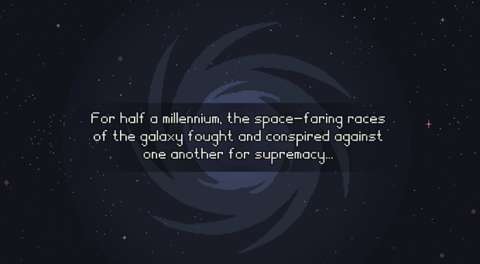
Unfortunately, this supremacy will not last. A previously unknown threat – called the “Chruul” - came out of seemingly nowhere, fielding living monstrous ships and equally monstrous crew. The Federation was overwhelmed, and it would appear that humanity risks extinction too.
Halcyon 6 is the last bastion of the Federation. It is a space station which is itself a Precursor artefact. It and its human occupants are the Federation’s last hope. However, the remnants are not only beset by the new enemy, but also other species which seek to exploit the Federation’s moment of weakness.
GAMEPLAY – OVERVIEW:
Halcyon 6 has been described as an indie take on the gameplay which the XCOM reboots have done. To elaborate, the player has a home base to conduct operations from, but the home base barely has the space to house the facilities which are needed for the operations. It takes valuable time and manpower to clear space in the home base, time and manpower which could have been used for other endeavours.
The player also has to juggle resources which are needed for so many things yet there are almost always not enough of them (unless the player is particularly skilled or lucky). There are also operatives and staff which the player has to send on missions to achieve strategic objectives and to improve their skills, yet each time the player does so, he/she puts their lives at risk of painful deaths. Replacements can be sourced, but rookies are always not on par with the deceased veterans (who can also be brought back, but at great cost).
Meanwhile, the player’s enemies grow in strength over time, launching attacks on the Federation’s meagre holdings (and later, the holdings of other species). If the player is not wise and skilled enough to counter the worsening onslaught while growing his/her forces, his/her playthrough is doomed to failure.
Such gameplay would be nothing new to veterans of the original X-COM, the XCOM reboot and other similarly inspired titles like Xenonauts. However, the gameplay in Halcyon 6 is perhaps a bit easier to digest than most. After all, in its current build at this time of writing, it does not have much of the complexity that the other titles have.
HALCYON 6 & FACILITY SPACE:
As mentioned earlier, Halcyon 6 is the player’s base of operations. It was not built from scratch, but is instead an existing structure of unknown make. Much of its interior is filled with initially unusable materials, which have to be cleared in order to make space for expansion.
Clearing space is a task which has to be assigned to an officer. There will be more elaboration on officers later, but it has to be said for now that clearing space is an important endeavour that matters in the long-term. On the other hand, it ties up officers which could have been sent on missions with short-term gains which are better than those gained from clearing space. Furthermore, there are only a limited number of rooms which can be cleared.
Fortunately, building facilities in rooms which have been cleared does not require the assignment of Officers. It does, however, take considerable time. Even the cheapest facilities take several days to be built, and the expensive ones would take days in the double-digits.
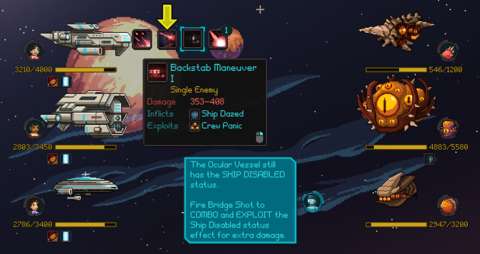
LATE IMPLEMENTATION OF ROOM SCRAPPING:
Making good use of the space which has been cleared on Halcyon 6 is important, because in the v1.0.0.5 build, there was no clear way to deconstruct rooms that have already been built. This was a major game design mistake that was fixed in v1.0.0.8, and only after a lot of complaints and harsh criticism by players too.
It is unfortunate that the game’s developers do not seem to realize that this should have been in the game early on. Considering that other established titles, especially the X-COM series, already have this feature, that developer Massive Damage does not seem aware of this even despite a period of Early Access testing gives the impression that they are not entirely wise in game-designing.
Furthermore, the developer’s initial response to these complaints strongly imply that this was a deliberate game design, with the intention of increasing the challenge beyond that of games which do have this feature. If this is indeed the case, this is not an innovation; it’s just laziness.
CREW:
“Crew” is a type of resource which the player will want to accumulate as much as possible, for a number of reasons.
First and foremost, crewmembers are practically the hitpoints of the space station. They are lost when a hostile fleet lays siege to the space station, or Chruul incursions take over rooms and use these as bases to ambush crewmembers with. If the counter for crewmembers runs down to zero, it is game-over. Fortunately, there are no limits on the number of crew which the player can have; one would wonder how much space there is in Halcyon 6.
Secondly, crewmembers are used in many ways that are either understandable or inhumane, but always practical. Foremost of these applications are that crewmembers crew ships, though gameplay-wise, they are spent like a currency; the player does not need to replenish the crew of a ship ever after it has been fully commissioned.
Third: crewmembers are the fodder that is fed into the harsh and dangerous officer training programme in the space station. Gameplay-wise, the player spends crewmembers like a currency to open up an officer slot.
Fourth: in the v1.1.0.0 build, there is a facility that lets the player use crewmembers to clone a dead officer back to life. This is useful, because there are ways for officers to improve themselves in addition to gaining experience levels, and these improvements cannot be easily replicated in a fresh officer.
CREWMEMBER RECRUITMENT:
Crewmembers are obtainable in a few ways, some of which might seem odd.
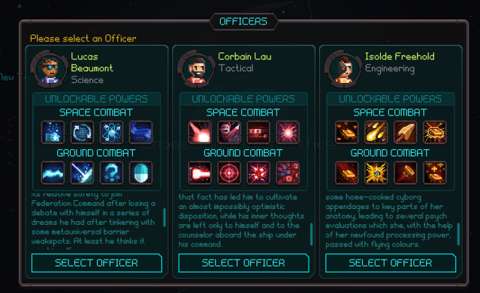
One of the odd ways is through placing a Tactical Officer in the Cadet Barracks after it has been built. This should not have been strange, especially considering that space sci-fi operas do have cadet academies and such other establishments for a long time in the history of entertainment fiction already. Yet, there is a narrative disconnect here: ever since the catastrophe which befell the Federation, Halcyon 6 is presumed to be left on its own and should not be receiving new personnel from elsewhere.
(There are random events which suggest that the new crewmembers are not obtained through natural means though.)
The other way of obtaining crew, and one which is perhaps more reliable, is to recruit them from Federation colonies which managed to survive the disaster. Alternatively, the player could evacuate entire facilities, bringing their staff in as additional crew. Narratively speaking, either way, the player is practically bringing in refuges.
DARK MATTER & MATERIALS:
“Dark Matter” and “Materials” are resources which the player needs to expand his/her hard assets, e.g. facilities and ships. Both are functionally the same; that is, they are currencies which the player spends to obtain something. There are two of them, if only to further complicate the gameplay element of resource juggling without increasing genuine complexity.
The game could have been more sophisticated if there had been more differences between these two resources. After all, since the designs of Crew and Fuel are more complex, more could have been done for these too.
Early in a playthrough, clearing rooms is the least risky way of gaining more materials. However, they do come with the risk of stirring monsters which are squatting on the space station; there will be more on these later when “ground combat” – as the game calls combat on foot – is described.
FUEL:
Fuel is an important resource. It is used whenever the player sends fleets to anywhere from someplace else. The amount of fuel which is consumed is proportional to the distance which is to be travelled by the fleets.
However, oddly enough, the return trip to Halcyon 6 will not cost any fuel. This likely has been implemented for the sake of gameplay balance, but it can be exploited in more ways than one. On the other hand, any attempt to divert a fleet to another place from a return trip will cause the fuel costs to be recalculated, specifically from the space station to this other place. (Moreover, the fleet will still return to the starbase anyway.)
Fuel does not have any other pervasive use, however. Nevertheless, it is in the player’s interest to accrue plenty of it, because fleet deployment is a considerable part of the gameplay experience.
FLEETS:
Fleets of ships are what the player needs in order to have a successful playthrough. The player will send fleets to defeat hostile fleets, undertake missions for other factions, and perform errands such as picking up resources from holdings, among other things which contribute to the player’s success (or failure, if the player has done a poor job of managing priorities).
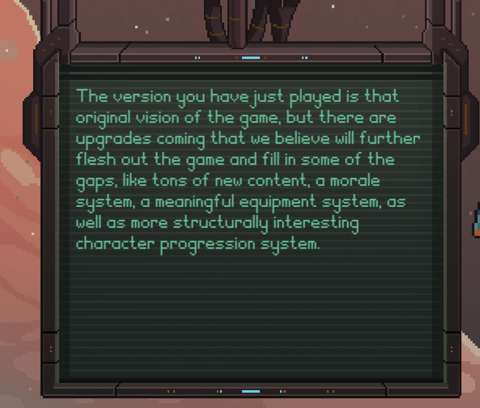
Setting up fleets of ships is quite easy, if the player can learn about the user interface which is used to do this. The game has a mostly competent tutorial which teaches this, but it appears to omit an important detail: an individual ship can belong to more than one fleet. Once a fleet which contains a ship departs, another fleet which has the same ship in it is not able to launch until the player replaces the ship.
This can seem a bit troublesome, especially much later into a playthrough when the player has to send out many fleets to achieve as many objectives in as short a time as possible.
There are not that many options to manage the ships in a fleet either. A fleet can only ever have three ships, and the player cannot arrange their position within the fleet. Fortunately, the position of a ship does not matter much in combat.
OFFICERS:
Officers are perhaps the player’s most important assets, since they are needed in order to make any progress. However, officers are ultimately mortal; they can die, and before the v1.1.0.0 build, they die permanently. Even with v1.1.0.0, bringing back a dead officer with cloning is a costly matter.
The other main reason to preserve the lives of officers is that higher-level officers are needed in order to expand the player’s assets, improve them and provide a buffer against failure. For example, there are rooms in Halcyon 6 which can only be explored by officers of higher levels, for whatever reason. In another example, there are ship upgrade projects which can only be undertaken by more experienced officers.
Fortunately, officers can obtain experience through many ways. Reliable and safe ways, such as having a science officer produce dark matter in a science lab, offer very little experience. The riskiest ways, namely engaging in a battle that certainly puts the officer’s life at risk, give the most experience.
After gaining enough experience, an officer gains a level. His/her proficiencies are boosted (to seemingly pre-determined levels) and he/she gains a point which the player can spend on the abilities which are available to his/her chosen specialization. The maximum level which an Officer can achieve appears to be level 15, meaning that there can never be enough points to max out all abilities.
At this time of writing, there are three main types of Officers: Tactical Officers, Science Officers and Engineering Officers. One would think that they should be working together on the same ship so it can have a balanced roster of senior staff, but for whatever reason, each Officer is the captain of his/her own vessel.
The different officer types have been implemented mainly for the purpose of complicating the fielding of ships. Each type of officer can only be the captain of one specific type of ship. In other things, they can do each other’s work, but with varying degrees of efficiency and effectiveness depending on their specialty with certain proficiencies.
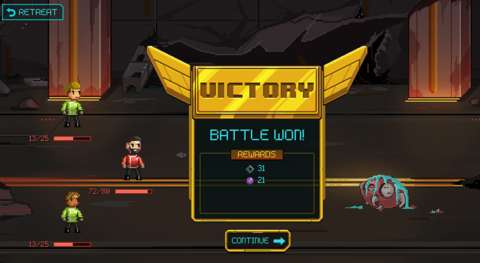
OFFICER PROFICIENCIES:
There are four types of proficiency which an Officer has, though only three of them are fully relevant in the v1.2.0.0 build.
Three of these are Tactical, Engineering and Science. Obviously, a type of Officer is better at his/her eponymous proficiency than he/she is at the others. However, the exact numeral ratings of these proficiencies are different from one individual to the next. As they gain levels, these ratings are boosted at semi-random amounts.
The proficiencies are used as factors in the calculation of the rate of progress which an Officer would achieve when undertaking a task. For example, an Officer with a higher Engineering proficiency will complete a Material-producing project earlier than an Officer with a lower rating.
There are generally few other uses for proficiencies. Therefore, the most which the player could do with them is to set Officers with the highest relevant ratings on the most currently important task.
LINGERING AMBIGUITY OVER SUITABLE PROFICIENCIES:
A task which an Officer can undertake will have its factors of completion displayed as a trio of coloured bars. Each bar is coloured according to the colour of its associated proficiency. As a general rule of thumb, a longer bar means that the associated proficiency matters more in this task.
There are tasks where the bars appear to equally long, such as the implementation of automated drones at facilities. This would suggest that any officer of any type would suffice. Yet, this is not always the case. Returning to the example of implementing automation, the Tactical Officer gets faster results than other Officers of the same level.
OFFICER TRAITS:
The proficiencies and specializations alone are not enough to make each Officer feel like a unique individual. Traits are what make them different.
Some traits are provided by the Officer’s specialization and level. For example, the traits which determine which tier of Starships which he/she can use depends on his/her level.
Every character starts with some traits which express their personality quirks or interests which they have before becoming an Officer. For example, a certain Tactical Officer has the ability to twist facts for purposes of propaganda.
Gameplay-wise, some of the traits come into play during certain narrative events; these traits enable options that generally allow the player to escape from “between a rock and a hard place” situations and also make a little profit. However, getting the correct Officer into the correct situation is a different matter.
Other traits may or may not be triggered during battle. For example, there may be an Officer with an issue of confidence over his/her combat performance. This in turn causes his/her ship to lose attack power when the ship is repaired. As another example, an Officer might have a trait which greatly increases the defence of a ship when it is struck by a critical hit.
Certain traits are obtained through engaging in battle. Some of these traits are beneficial, and are often awarded as a seemingly random reward for a successful battle. These traits differentiate Officers which had been going on combat missions more often than the others.

There are bad traits which are inflicted on surviving Officers if they retreat from battle. For example, retreating from a battle with Chruul causes any Officer who turned tail to gain a trait which makes him/her more vulnerable to Chruul attacks. The acquisition of these traits is a certainty.
This contrasts greatly against the beneficial traits which are randomly obtained through victories. However, they have perhaps been implemented to discourage the player from exploiting hit-and-run attacks against enemies; after all, they (and the player’s own fleets) retain any damage which they have sustained earlier, which might have made hit-and-run attacks a bit too expedient.
OFFICER SKILLS:
In this game, “Skills” are special actions which Officers can perform when they are in ship or ground combat. Most skills have cool-down times, but those which do often have considerable tactical value.
Every officer has a repertoire of skills which he/she can learn and develop. The types of skills which he/she has are mainly determined by his/her specialization. For example, Tactical Officers have hard-hitting skills which when coupled with the relatively low hit-points of Tactical-class ships (and their own low hit-points), means that they are glass cannons.
Every time an Officer gains a level, he/she gains a point to spend on learning new skills or improving already-learned ones. However, doing the latter requires that the Officers have reached the prerequisite levels, which are generally multiples of 3, plus 1. An Officer has up to 8 skills which can be learned and improved. It is generally in the player’s interest to at least have the Officer learn each one.
It is worth noting though that Officers of the same specialization have different combinations of skills. This means that the player can have fleets which are composed of ships of the same type and still have balanced capabilities, if their Officers have skills which compensate for the weaponry which the ships have. (In the v1.1.0.0 build of the game, ships can have their weaponry customized, so having Officers with different combinations of skills is no longer the only way to achieve this.)
NON-HUMAN OFFICERS:
Most of the Officers under the player’s employ are humans. However, there are a few opportunities to gain Officers who are not human; one of these can happen at the penultimate stage of the playthrough, if the player has curried much favour with the other species.
In practice, they are not much different from humans; they have the same repertoire of skills. However, they are the only Officers who can captain alien ships, which have weaponry that are much different from those of the human ones.
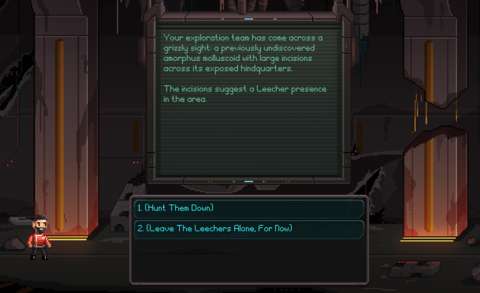
LEGENDARY OFFICERS:
There are certain human officers who happen to be “legendary” officers. In addition to having particularly silly backstories, they have “Epic” skills which can be unlocked when they are level 7. Incidentally, the player gets to pick one Legendary Officer at the start of any playthrough.
Their “Epic” skills set them apart from the other Officers. These are skills with particularly high tactical value. For example, there is Corbain Lau’s “Doom!” cannon, which inflicts incredible damage against a single target; when combined together with damage bonuses, it is one of very few skills which can achieve five-digit damage output.
However, “Epic” skills can only be used once for each foray away from the space station. The Officers must return to the space station with their ships in order to restore the use of these skills.
SHIPS:
Ships are the player’s next-most valuable assets, after Officers. Without them, the player cannot undertake any missions away from the space station, which will in turn quickly starve the player of much needed resources and other opportunities to expand.
Although each ship needs an Officer, an Officer does not need a ship to be useful; he/she can still do things around the base. Nevertheless, it is in the player’s interest to have a ship for each Officer, if only to have more options on what to do with the Officer. However, this is not always possible, because ships are very expensive assets to manufacture.
Furthermore, unless the player is very familiar with how the hull points of ships can be retained after combat, they are not easy to keep in tip-top shape, due to reasons which will be described later. Besides, ships which are destroyed remain destroyed (together with their commanding Officer); the game, if anything else, is punishing (at least against unskilled players).
However, there are a few game designs which help the player get by with existing ships. The foremost of these is that ships have their own progression system, albeit a very simple one which is governed by only a few factors. The first of these factors is how many enemy kills which it has scored, and the quality of these enemies relative to the ship (e.g. having a powerful ship smash apart low-tier ships is not going to grant much reward). The second, lesser factor is how many battles which it was victorious in. As these factors get higher, the probability of it gaining a rank in “reputation” increases.
When this happens, the ship gains notable crewmembers, which improve its performance. Gameplay-wise, these crewmembers are practically permanent buffs which cannot be removed in any way, i.e. these crewmembers cannot be killed. They cannot be transferred onto other ships too.
Eventually though, the player will need to upgrade to higher-tier ships in order to be able to cope with the rising challenges. After all, the enemies of Halcyon 6 and the Federation will grow in power, and they will not wait for the player to catch up. Therefore, unless a ship is already of the highest tier, any experience which it has accrued has to be wasted.

SHIP REPAIRS:
Although Halcyon 6 has a powerful sci-fi matter-creating device which can fabricate entire ships in days and repair damaged ships instantly, it does not have much in the way of efficient over-time repair facilities. The player can spend Dark Matter to immediately restore the hitpoints of a ship before it departs from the space station, but this comes with major opportunity costs.
A cheaper but riskier way to repair a ship is to use repair skills and devices on a ship during battle; any “hull points” (i.e. hitpoints of ships) which have been restored are retained past the battle, assuming that the player does not lose them to enemy attacks anyway. Furthermore, repair skills and devices have limited uses (though they are replenished after every battle).
The least risky means of repairing a ship is to have it stay at the space station. It will be repaired over time, but at a very slow rate. This rate can be improved with R&D (more on this later), but it remains slow throughout a playthrough.
Furthermore, in order to profit from the over-time repairs at the space station, the player has to have spare ships, i.e. more than one ship to each Officer. This is a highly unlikely course of progress that the player could use and prosper with; the opportunity costs from spending resources on ships instead of other things can be very high.
NO SHIELDS:
For a game with a space sci-fi setting, it is odd that ships do not have shields, i.e. regenerating hitpoints in gameplay terms. Any damage which a ship would take is immediately applied against their hull points. (That said, there are ship equipment and officer skills which grant protection to ships, but these act as damage reduction buffs.)
The upside is that ships do not worsen in terms of performance as they take more damage. However, this also applies to enemies too.
SHIP STATISTICS:
In addition to their hull points, ships have other statistics such as its defence (which reduces incoming damage), speed (which determines how often it can act relative to other ships in the battle), and base damage (which is perhaps the most important statistic, as it determines its overall damage output).
For every class and tier of ship, there are two variants. They have access to the same weaponry (though this was not the case before build v1.1.0.0), but they have slightly different statistics as well as costs in dark matter and crew. As an example of the differences, one of the two variants usually has better long-term damage output, but they are noticeably weaker than the other variant.
As mentioned earlier, the statistics of a ship can be improved by increasing its reputation and gaining “elite” crewmembers. In the current build at this time of writing, the elite crewmembers still cannot be transferred to other ships. This restriction is likely there for the purpose of gameplay balance, but if it had been implemented, the gameplay would have had more sophistication.

SHIP WEAPONS & CUSTOMIZATION:
Each ship can carry several weapons. Gameplay-wise, these act as equivalents of officer skills. If the player is expecting something as complex as changing ship components like engines and sensor suites, he/she would be quite disappointed because there is no such gameplay element in Halcyon 6. The player can change the weapon load-outs of a ship, however.
Prior to build v1.1.0.0, the number and combination of weapons of each ship of a specific class and tier was fixed. This was terribly limiting. This issue was eventually addressed in build v1.1.0.0. In this build and the ones after, the player can make selections from the set of weapons which is unique to a variant of a ship of a specific class, regardless of its tier. The tier of the ship determines the number of weapons which it can have instead.
All tiers of ships of the same variant has access to the same set of weapons. However, the tier of a ship determines the damage output of its weapons. After all, the weapons are inflicting damage which is calculated by multiplying the base damage of the ship with percentile factors.
NON-FEDERATION SHIPS:
As mentioned earlier, there are non-human Officers which the player might be able to obtain (usually temporarily). They often come with their own non-Federation-issue ships. These tend to be more powerful than any ship which the player has at the time, and are often the reward for building goodwill with certain factions. Perhaps the game could have been more fun if the player can keep them around for longer, but this is not so.
TURN-BASED COMBAT:
In Halcyon 6, violent conflict occurs via turn-based combat. To be specific, the variant of turn-based combat which is used is the kind which uses the speed ratings of the participants to determine when they can take an action and how frequently that they can do so relative to the other participants. This has been seen before in games like Ubisoft’s Heroes of Might and Magic games.
SPACE COMBAT:
Space combat is a simple affair of ships taking turns to slug it out. They may apply de-buffs and buffs on each other, but there are not any special six-axes maneuvers despite combat taking place in space. Halcyon 6’s space setting is just in name only, to make a simple statement.
GROUND COMBAT:
In addition to combat in what passes as space in Halcyon 6, there is combat on foot (or any terrestrial appendage, in the case of non-humanoids). This usually happens when monsters are encountered aboard the space station, or when something has to be retrieved by an “away team” from a location. (The game does use Star Trek terms.)
Ground combat has to be initiated with at least one Officer in the player’s team. Preferably, the player should fill the whole team with Officers, but this is not always possible, especially for hostile encounters while exploring the rooms in the space station.
Anyway, each of the combatants has their own set of skills; in the case of human Officers, they have up to four of these for ground combat. As mentioned earlier, each individual Officer may have a different set of skills from that of another Officer of the same class; this is because there are many more than just six skills for each class.
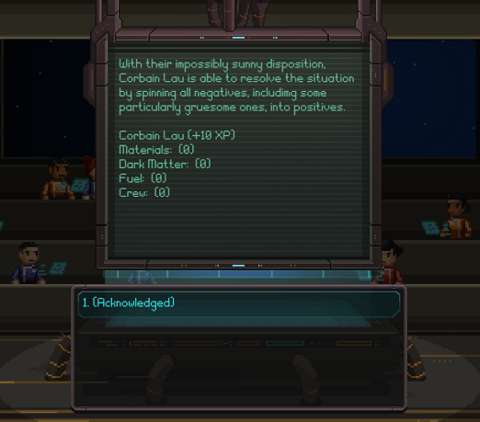
The player cannot change the skills which an Officer has access to, however. This means that balancing a team of characters for ground combat can be difficult, and made all the more so by the need to have a fleet of ships with balanced abilities.
Perhaps the game could have had a feature to customize the skills of an Officer, like the player could with the weaponry of ships.
Anyway, like space combat, the player’s objective is to whittle down the opposing team, i.e. reducing the hitpoints of every enemy to zero, while keeping his/her own team alive. In fact, it plays a lot like space combat, only with characters instead of ships.
If the player’s team has only a single Officer, the other two slots can be filled with this game’s equivalent of Star Trek’s “Redshirts”, the Cadets. These individuals are far less capable than Officers, however. In fact, the enemy is very likely to murder them, if the player cannot quickly overpower the opposition. Losing them is not as bad as losing Officers, but every death of a Cadet does count against the player’s reserves of Crew (though at a one-to-one rate, thankfully).
Fortunately, there are options to improve the combat capabilities of the Cadets. Of course, this entails the opportunity costs of spending resources on these instead of something else.
CHANCE-TO-HIT:
For better or worse, Halcyon 6 makes use of RNGs for the possibility of an attacking hitting the target(s) or missing entirely. Fortunately, most of the time, the percentage to hit something is usually 100% or more, because the base percentage for most attacks are 100%. There is no imposed maximum percentage that is below 100% either, meaning that hits can be guaranteed.
However, evasion ratings and aiming de-buffs reduce the percentages. On the other hand, the player can still do something about this if the player is the one with no guarantees of hitting something instead of the enemy. For example, aiming de-buffs can be removed by using Engineer-applied healing, and the evasion ratings of enemies can be reduced by applying the “Confused” de-buff.
COOLDOWNS & WARM-UPS:
There are some skills which are more powerful than the rest, due to higher damage multipliers, more debilitating de-buffs and/or more powerful buffs.
The power of these skills is balanced by “cool-downs” and “warm-ups”. “Cool-downs” should be familiar to players who are experienced with balance design practices; after a skill with a cool-down rating has been used, it will be a while before it can be used again.
“Warm-ups” are introduced in the v1.1.0.0 build in order to balance skills which are very potent if used right from the start of a fight. These are a variant of cool-downs, albeit that they are applied at the start of every fight. In other words, a skill with a “warm-up” rating cannot be immediately used during the first turn; the player has to wait a number of turns as indicated by the “warm-up” rating.
Cool-downs and warm-ups also apply to enemies too. Overall, the implementation of these two gameplay elements makes fights much more manageable, though a lot slower as a consequence.
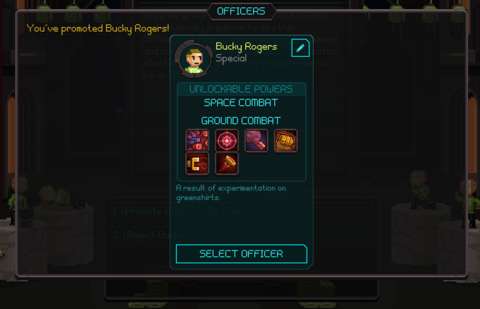
RESISTANCES, VULNERABILITIES & PROBABILITIES OF DE-BUFFS:
De-buffs are useful debilitating effects which can be applied on enemies in order to reduce their combat performance. However, in the early builds of the game, it was quite easy to win a fight by piling de-buffs onto enemies, or to lose a fight by having de-buffs piled on the player’s characters.
This has been addressed conclusively by the cool-down and warm-up mechanisms, but before these, there were – and still are – resistances and probabilities of applying de-buffs. Any skill which can apply a de-buff has a base probability of being applied. This base number is further modified by the resistance of the target towards specifically this de-buff.
The resulting percentage is the chance of the de-buff being applied. Naturally, the player will want to avoid using de-buffs on enemies which are resistant to them.
Conversely, the target may have vulnerabilities instead of resistances, i.e. it is much easier to apply the relevant de-buffs on them. Recognizing these is a key to victory against specific enemies.
STAR SYSTEM CONDITIONS:
Previously, the nature of any star system only matters with regard to the economics of resource management. One of the updates in between v1.0.0.5 and v1.2.0.0 introduced a gameplay element which made the conditions of a star system matter more in space combat. (These conditions are not related to the economic significance of the star systems.)
Examples of conditions include psychic emissions which make the application of the “Confused” status much more difficult. These conditions make the use of certain weapon load-outs more difficult to utilize for maximum effectiveness, so it is in the player’s interest to kit out the player’s ships such that they are prepared for these conditions.
COMBOS:
The aforementioned de-buffs are not just for debilitating enemies with. The player can choose to end their effects earlier than their durations suggest by attacking de-buffed enemies with skills and weapons which exploit these de-buffs. This grants bonus damage to the attack.
Prior to v1.1.0.0, the bonus damage which can be inflicted by making combos can be considerable. After v1.1.0.0, it is more difficult to apply de-buffs onto anything due to higher resistances across the board.
This was done to address complaints by players who had been defeated by faster enemies which had the opportunity to pile de-buffs and exploit them before the player could even do anything. On the other hand, the changes also dilute the potency of this gameplay element.
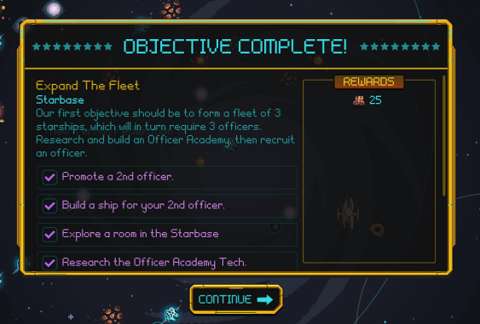
Nevertheless, the combo system remains the gameplay element that sets the experience of combat in Halcyon 6 apart from those of so many other games which use turn-based, sequence-oriented battles.
Moreover, although this system is a variant of the gameplay feature of element-matching (e.g. using water or ice attacks against fiery enemies in other games), it does have the player juggling the need to maintain de-buffs against ending them earlier for bonus damage.
WHITTLING DOWN ENEMIES & RETREATING:
If the player instigated a fight, the player may – but not always – have the option to have his/her team retreat. This is not immediate, however. It takes at least one uninterrupted turn for a character or a ship to retreat. Until this time, the character or ship can be hammered by enemies.
Enemies which the player has failed to annihilate in a single battle will retain any damage which they have sustained. This might be important to keep in mind when the player begins to encounter particularly powerful enemies, such as the Chruul’s super-sized ships.
If the player doesn’t want to sacrifice entire fleets and their Officers to whittle down these enemies, the player can choose to have his/her ships unload their most powerful attacks in the first few turns and then retreat before the enemies can bring their full might to bear. Then, the player can repair these ships and throw them back into the fray.
However, as mentioned earlier, there is a mechanism in place to discourage such practical but cowardly tactics; this would be the acquisition of shameful traits for Officers who partake in these strategies; these traits happen to damage their combat performance in the long run. Furthermore, any enemies which have been destroyed in the hit-and-run attack do not yield any loot.
NO RETREAT WHEN AMBUSHED IN TRANSIT:
As of the v1.2.0.0 build, there is no retreat for a fleet which has been ambushed by enemies while in transit.
This can be a major problem, especially if the player is having single-ship “fleets” going around doing errands. In fact, if the player wants to be efficient in expanding his/her assets, the player will need to do exactly this, at least until resources are no longer a problem. However, single-ship “fleets” are particularly vulnerable to these ambushes, which are otherwise easy to brush aside if the fleet has a full roster of three ships.
LACK OF GROUND COMBAT RELATIVE TO FREQUENCY OF SPACE COMBAT:
Prior to the v1.1.0.0 and v1.2.0.0 builds, there was much, much more space combat than ground combat in any playthrough. The skew is apparent, giving an impression that there is not much utilization of the gameplay element of ground combat. Consequently, it also meant that putting skill points into ground combat skills rarely provide pay-offs.
In those later builds, there are more circumstances which lead to ground combat, such as retrieving resource caches from ruined facilities which are typically inhabited by monsters. There is still a preponderance of space combat though, mainly due to the fact that most of the ground combat occurs through missions and events. In contrast, space combat can be initiated by moving a fleet onto a locale that already has a hostile fleet.
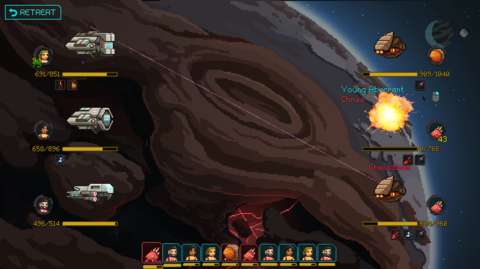
OUTSTATION FACILITIES:
As mentioned earlier, the player will need resources from holdings outside of the space station. These are facilities which are situated in star systems within Federation space.
The locations of all of the facilities within Federation space are known to the player early on. What is not known is their initial status. They may still be operational, or have already been destroyed by the Chruul. The player has to be updated on their status by visiting them with a fleet, waiting for them to emit a distress signal, or waiting for a Chruul fleet to “visit” them instead (which causes them to emit a distress signal anyway).
(By the way, their statuses are actually pre-determined; they are not procedurally generated. An observant player – or one who refers to third-party documentation – can plan for which facilities to check before the rest.)
Operational facilities produce resources at various rates until they fill up their holding capacity. Facilities can be upgraded in order to improve their holding capacity and resource generation rate. However, this takes time and resources. The time taken can be reduced by assigning the correct officer to the upgrade option to be undertaken.
Operational facilities obviously do not produce any more resources after they have reached capacity. This means that if the player wants them to continue contributing to the player’s campaign, they have to be emptied out by a visiting ship.
Alternatively, if the player would prefer to free up ships to do something other than fetching resources, the player can upgrade facilities with drones, which automatically ship resources over to the space station. However, the drones take a few days to load their cargo. Furthermore, if any drones reach the space station while the latter is besieged, they are destroyed along with their cargo.
If the Chruul or some other hostile faction besieges a facility with a fleet, it is not automatically destroyed. The player has up to 30 days to rescue it (less in later chapters), which may seem like a lot of time. However, in practice, 30 days may not be enough, because there would be many, many other things to do and only so many officers to direct around. Failing to rescue it means the facility is destroyed. Furthermore, while the facility is besieged, it does not produce any resources and gradually loses any resources which it has stockpiled.
Interestingly, as long as the player can lift the siege on a facility, it retains all of its upgrades, i.e. no lasting damage is inflicted.
If the player believes that he/she cannot hold onto a facility, he/she can choose to evacuate it. This grants the player’s fleet a lot of Crew, but the facility is practically destroyed afterwards.
Prior to the v1.1.0.0 build, destroyed facilities do nothing. Having facilities destroyed means that the player is permanently hampered. After that build though, destroyed facilities can be rebuilt with the expenditure of Crew. This makes failure less punishing, but the permanent damage is replaced with opportunity costs instead.

RETURNING COLLECTED RESOURCES TO SPACE STATION:
When one of the player’s fleets visit a facility to empty out its resources, the resources do not immediately go into the player’s accounts. The only exception is Fuel, which is always transferred into the player’s account for Fuel.
As for the other resources, they go into an unseen counter instead of the main resource counters. There does not seem to be any display for this hidden counter, unfortunately, which is a significant design gap. Anyway, these resources are not immediately returned to the space station. To do so, the fleet has to return to the space station and deposit their collected loot. Obviously, if this fleet is destroyed in a battle, the resources are gone.
This system is also used for some quests. These quests require the player to return something to the space station, such as samples of Chruul organic matter. In these cases, the fleet which retrieved the stuff has to return to the space station. Presumably, if the fleet is destroyed, the player would suffer a setback in the pursuit of the quest. (I have yet to personally suffer any such setback, however.)
AUTOMATED FREIGHTERS:
As mentioned earlier, facilities can be upgraded with drones so that these ship resources over to the space station after the facilities have reached capacity. This is convenient, but it does have a small setback: it takes days to completely empty the capacity of a facility into a drone. During this time, any further production is halted (and thus wasted).
Furthermore, the approach to the starbase (which is implemented in-game as an actual location) must be clear of any hostile ships that are besieging the station. Otherwise, the drone freighters are destroyed when they reach the starbase approach. The facilities retain their automation conveniences, fortunately.
TECH TREE & RESEARCH:
Halcyon 6 has a typical video-game ‘research’ system, in which the player spends resources in order to unlock benefits, advance the capabilities of his/her assets and/or make further progress in the playthrough.
In the v1.0.0.5 and earlier builds, there are not many research options beyond statistical upgrades and unlocking the options to build things. In the later builds, there are a bit more to be undertaken, such as a line of research options which reveal the true nature of the Chruul.
Some research options are not available until the player has reached certain milestones in a playthrough. For example, the ability to build Tier 4 ships is not available until the player has reached Act 2.
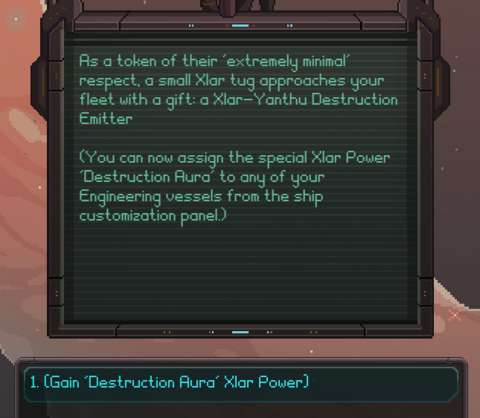
Most research options can be taken immediately upon paying the resource costs for them; these options are displayed in the user interface for a specific room in the space station. However, there are some options which are implemented like tasks, meaning that they require the player to assign Officers to them. For example, research options which upgrade the statistics of a specific class of ships require the assignment of Officers to them, preferably the kind which are associated with that class of ship.
MANAGING TASKS & TIME:
There are always more resources to be had; they can be collected from facilities, collected as loot or produced by Officers who are working at resource-creating rooms.
Time is what the player does not have much of. Like X-COM and its inspired-ilk, the challenge which the player faces in a playthrough of Halcyon 6 grows over time, regardless of the player’s place in the story. In particular, the strength and versatility of the enemies which the player would face increase over time. Furthermore, there are quests which have time limits. Foremost of these are the lifting of sieges on facilities, though there are also timed quests which have been introduced in the v1.2.0.0 build.
Therefore, it is in the player’s interest to be as efficient as possible, especially with the assignment of Officers, while also planning for the future. For example, wise players would go for options which make more Officers available first, but might also want to invest time in options which ensure that they are of an initial level which is as high as possible. As another example, Officers who have reached threshold levels which allow them to explore more rooms should be assigned to do exactly that.
This is key to the success of every playthrough. If the player has been efficient, he/she would be encountering enemies which the player’s Officers and ships can wipe out easily (though this can cause a playthrough to become quite boring).
CAMPAIGN PROGRESSION:
Although there is a counter for the number of days which have passed in the player’s playthrough, the player’s progress is marked by the achievement of mandatory quests.
Despite the aforementioned gameplay element of things becoming more difficult over time, it is usually in the player’s interest to delay the pursuit of these quests until the player’s Officers and assets have improved enough to handle the coming challenges. This is because the completion of the mandatory quests triggers immediate increases in the strength and versatility of enemies.
If these mandatory quests bring the player into the next stage of the story, their completion also triggers the introduction of additional quests, some of which are timed. The player could end up being swamped with many quests but not enough time to pursue them. It would be a great loss indeed if these optional quests lapse, because their completion would have rewarded the player with things other than more resources, such as additional Officers and weapons for ships.
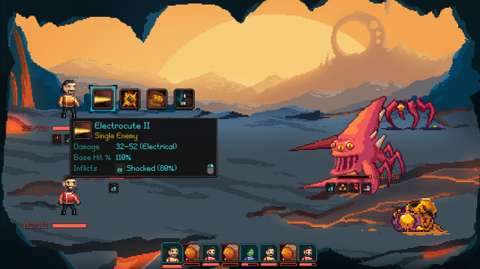
There are some mandatory quests which cannot be fulfilled until a certain number of in-game days have passed. This is the case for the quests which involve the arrival of particularly powerful Chruul champions. An experienced player may be confident that he/she already has the strength necessary to complete these quests, but there does not appear to be any way to cut the waiting time short.
ENEMIES – OVERVIEW:
There are many things that would want to kill Federation humans for all kinds of reasons. However, they can be defeated and have their remains looted, if the player can learn about their strengths and weaknesses.
Firstly, there are the Pirates. These often field weak ships, even at the later stages of a playthrough. They are mostly in the game for the player to beat down on, though a moment of carelessness would allow them to punish the player severely.
Next, there are the vessels of the five non-human but humanoid species: the Xlar, the Collective, the Korzan, the Yabs and the Voraash. The ships of one species are different from the ships of other species in notable ways. However, they still follow ship archetypes, e.g. the Xlar has a vessel which is equivalent to the science vessel.
Finally, there is the Chruul, which are the most pervasive enemies in the game. They field organic ships and their Officers are living weapons themselves, but gameplay-wise, they behave much like the ships and Officers of any other species.
The ships of the various species seem to have different weapons, but most of these are actually ‘staples’ which the player has access to. There are weapons which inflict a de-buff (or two at once), hit a single target or hit all three on the opposing side, or exploit de-buffs for bonus damage.
However, each species appears to have a few tricks which are unique to themselves. For example, the Collective’s ships gain automatic bonus resistances to de-buffs which are inflicted on them (not unlike the Borg in Star Trek). As another example, the Chruul’s Engineer ship-equivalents have the annoying ability to remove any buffs which the player has applied on his/her own ships.
Therefore, it is in the player’s interest to know about these abilities and recognize the ships which have them. For example, the player might want to refrain from using any buffs, especially those with limited uses, before the aforementioned Chruul’s Engineer ship-equivalent is destroyed.
The same advice can also be applied to ground combat. However, due to the relative lack of ground combat, there are not many opportunities to learn about the enemies which would appear in this part of the game. Furthermore, the player only ever fights the Chruul and monsters in ground combat; fights with individuals of humanoid species appear to be absent from the game.
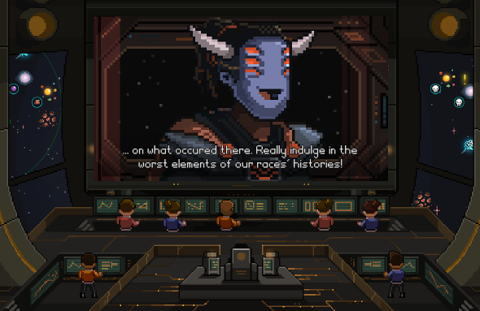
VARIANTS AND “AGES” OF CHRUUL:
After a certain update prior to build v1.2.0.0, Chruul ships can spawn as one of several variants, which determine their resistances and statistics. For example, “Android” Chruul are practically immune to the Hull Breach de-buff, but are particularly susceptible to Sensors Offline. An observant player will take a while to make associations between these variants and their statistics, but it does reward the player for having a fleet bring along a mix of weapons for fighting Chruul with.
Chruul “ships” and “Officers” also have ages, as depicted by the adjective in front of their names. Presumably, these are the equivalents of the experience levels of the player’s ships and Officers. The adjectives appear to affect non-resistance statistics only though.
CHRUUL BOSSES:
Eventually, the player has to encounter and fight the Chruul’s champions. As to be expected of such enemies, they are very tough, and can inflict considerably more damage than enemies of lower class.
There is one design which makes them different from (but not necessarily better than) the usual run-of-the-mill bosses: the damage which the player can inflict on them is capped at specific numbers. This means that the player has to inflict a certain minimum number of hits anyway to kill such a boss. For example, at the default difficulty, there is a boss at the end of Act 1 with over 9500 hitpoints with a damage cap of 500, so 18 hits will be the minimum which is needed.
Although it does increase the difficulty of boss fights, it is a contrived design which imposes artificial and unconvincing challenge. The developers could have resorted to more elegant means of determining the level of challenge that would best entertain a player. For example, there could be checks on the number of battles which the player has won, how quickly they were won and how many hitpoints the player’s ships have remaining, among other factors, in order to determine how many hitpoints that the boss would have.
ALL ENEMY VESSELS VISIBLE IN GALACTIC MAP:
All fleets, including those not of the player’s, are visible in the galactic map. The player can select their icons and have their composition revealed. A right-click on their portraits also reveals their statistics and abilities.
In other words, much of the information which the player needs in order to gauge the strength of enemies is readily available. Therefore, if the player gets into a battle where the player’s fleet is overmatched, it is really the player’s own bungling fault.
The only time when the player might be caught unprepared is when an enemy fleet is spawned within the same star system that the player’s own fleet is stationed in. In such a case, battle commences immediately after the hostile fleet is spawned.
On the other hand, this risk is much warranted if the player is having a fleet sit on top of a location which is a monster closet, as informed to the player. For example, there are self-perpetuating portals which the Chruul uses to bring fleets in during the second Act. Understandably, if the player’s fleet lingers on top of the portal, it will be immediately attacked by the next Chruul fleet which appears, and the latter is likely to be of a composition that is different from the previous one.
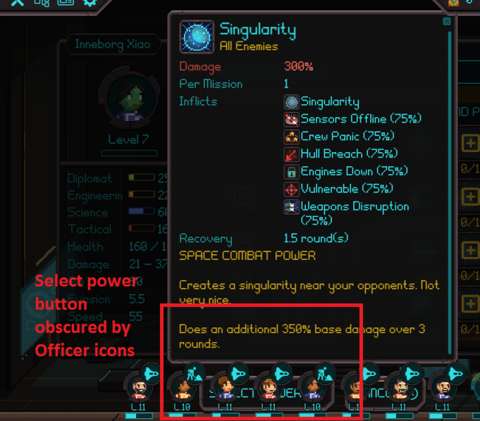
SIDE QUESTS, ERRANDS & DIPLOMACY RATINGS:
In addition to the mandatory quests which move the overarching plot of the threat from the Chruul, there are quests which concern the other species. These are primarily intended to expand on the backstory of these other species. For example, there are a couple of quests which concern the ruthless Xlar, a species of so-called “warrior geneticists” who genetically modify their next generations, who in turn destroy their progenitors if they turn out stronger. Some of these quests provide special rewards, such as an additional weapon for a class of ship. Others give more mundane returns, such as more resources (sometimes when the player no longer needs them).
Ultimately though, most of these quests will require the player to destroy targets, or assign Officers to tasks which require time to complete but otherwise have no further complexity. In other words, the player does what the player has already been doing in the rest of the playthrough.
Incidentally, many of these quests were implemented in the v1.2.0.0 “Diplomacy” build, which is trumpeted as “free DLC” by the developer. Considering their lack of sophistication and contribution to the gameplay, they might as well be free.
Anyway, the player’s main incentive to pursue these quests is the change in the Federation’s relationship with these other species. This relationship is depicted via the “Diplomacy” rating that is shown under the details window for each species’ capital planet. (It would have been more convenient if the rating is shown in the galactic map instead.)
At the finale of every Act of a playthrough, the species which have good relationships with the Federation might offer some form of assistance. For example, at the end of Act 1, any species which has goodwill towards the player might send out fleets to assist with a particularly severe Chruul incursion.
VISUAL DESIGNS:
Halcyon 6 is another one of those indies which utilize pixel art. Of course, this would not be an issue to those who have yet to become bored with pixel art graphics.
Anyway, this game’s artstyle is such that humanoid characters are rendered as super-deformed figures, e.g. oversized heads and small limbs. Most of the sprites appear to have been deliberately animated pixel by pixel; very few of them make use of present-day animation tools which give animation-bones to sprites.
On the other hand, there are not a lot of animation frames. The game attempts to compensate for this with doles of other visual effects. In particular, combat often occurs with dazzling flashes, pixelated explosions and a lot of sprite-shaking. The graphics are enough to tell the player what is going on, but there are other games with pixel art which is more convincingly sophisticated and which does not rely on so much superficial aesthetic flare.
The user interfaces, for the most part, are adequate for the purpose of gameplay. However, there are a lot of instances where tooltips and windows obscure each other; there does not seem to be any way to address this. In one case, which is shown in one of the screenshots for this article, the problem is severe enough to be a significant gameplay issue.

SOUND DESIGNS:
Regarding the sounds which the player would hear while playing Halcyon 6, there are only two major categories of sounds to be heard: music and sound effects. There are no voice-overs whatsoever in the game (which is perhaps just as well for an indie game).
The music makes a good first impression. It evokes a sense of wonderment and foreboding, which fits the sci-fi setting and the plot element of being under siege from enemies with unknown capabilities. However, there are not many tracks in the music, which means that eventually, the music will sound all too familiar.
As for the sound effects, most of these are heard in combat, including space combat. (Halcyon 6 is of course that kind of space sci-fi game which wilfully ignores that the vacuum of space is not likely to be conducive to audio transmissions.)
Anyway, there is a considerable variety to the aural qualities of the sound effects. For example, there are metallic booms with deep reverbs which accompany explosions of dying ships, which contrast greatly against the wet squirts which accompany the spitting attacks of certain Chruul.
These sound effects are quite satisfying to listen to, at least before the player reaches catharsis from the experience of playing the game.
STABILITY ISSUES & IMPROVEMENT:
In the v1.0.0.5 build of the game, there were lingering issues of stability, especially in the galactic map screen during the late-stages of a playthrough and when visually elaborate attacks occur during battle. The frame rate would chug, and very rarely, the game might crash.
This has been addressed in the v1.2.0.0 build onwards. Although this is easily appreciable, it also reinforces the impression that the game has been released without much technical polishing.
Unfortunately, the implementation of the additional quests in v1.2.0.0 introduced more bugs, specifically bugs which affect the quests. For example, there are quests in which a human Officer is to be examined by aliens. The Officer which has been assigned to the quest is supposed to gain certain traits, but this does not always happen.
AMUSING WRITING:
One of the significant appeals of the game is its writing, which can be seen in the backstories of Officers and the conversations between the player character (who is the commander of the starbase) and the representatives of the other species. For example, the other species express plenty of contempt and derision towards humans in different ways, from the occasionally candid and very loud proclamations of the Xlar to the sarcastic and condescending remarks of the Korzan.
What are perhaps even more amusing are the player’s options for a response; one of these is always a cynical and dry remark. (Incidentally, this remark is best made when the other species are pleading for help from the Federation.)
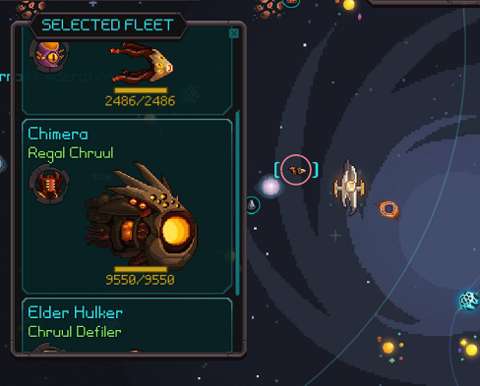
Unfortunately, there is not enough writing interspersed in between stretches of gameplay, which itself can seem all too familiar eventually (especially to a skilled and meticulous player). Perhaps the experience of playing the game could have been more enjoyable if the same kind of writing can be seen in places outside of conversations and Officer backstories, such as in the quest descriptions.
PARTING STATEMENTS:
To faithful followers of Halcyon 6, the criticisms of the game in this article can seem harsh and unfair, especially considering that Massive Damage did appear to deliver on most of their promises on fleshing out the game from the “feature-complete” launch build.
However, not everyone can be readily able to give game-makers the benefit of the doubt. “Better late than never” is not an ethos that everyone follows either, especially when a guarantee or collateral is not provided. Halcyon 6 is and will be an example that would be brought up as an advisory tale of “wait-and-see”. (Of course, in this case, the game turned out alright.)
That said, Halcyon 6 benefits from the attention of game designers who have ideas on how to improve their game, as well as the skill to realize these ideas. The only problem is that they do not have the capability to implement them on time before they bring their product to market in order to earn much-needed revenue. That any additional gameplay content which they implement almost always end up having bugs (which they will fix later) also point to lack of experience in quality assurance on their part.
If there is any praise that Massive Damage deserves, it is that their products would only be worthwhile after it has benefited from months and months of feedback from customers who are willing to be their playtesters.

